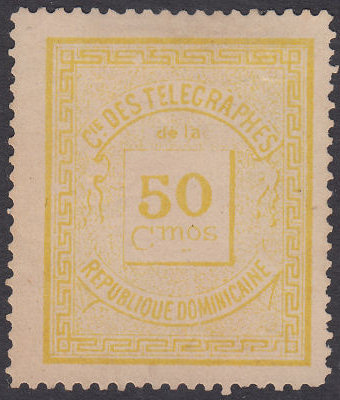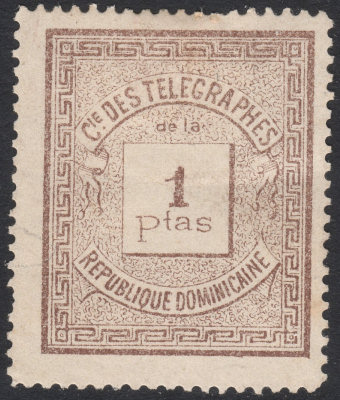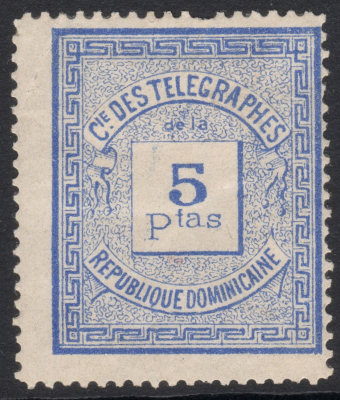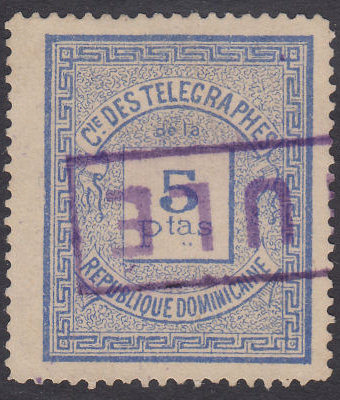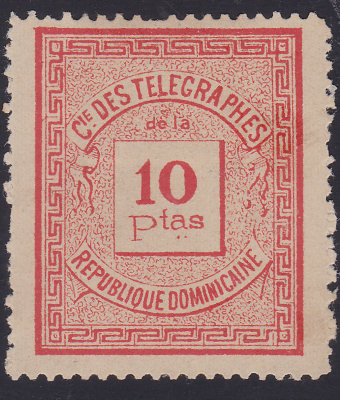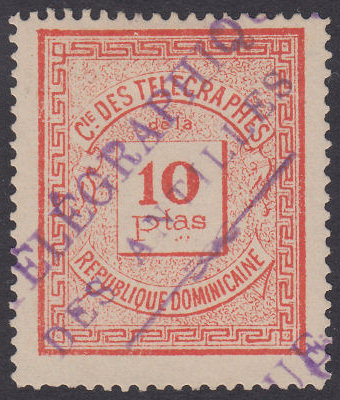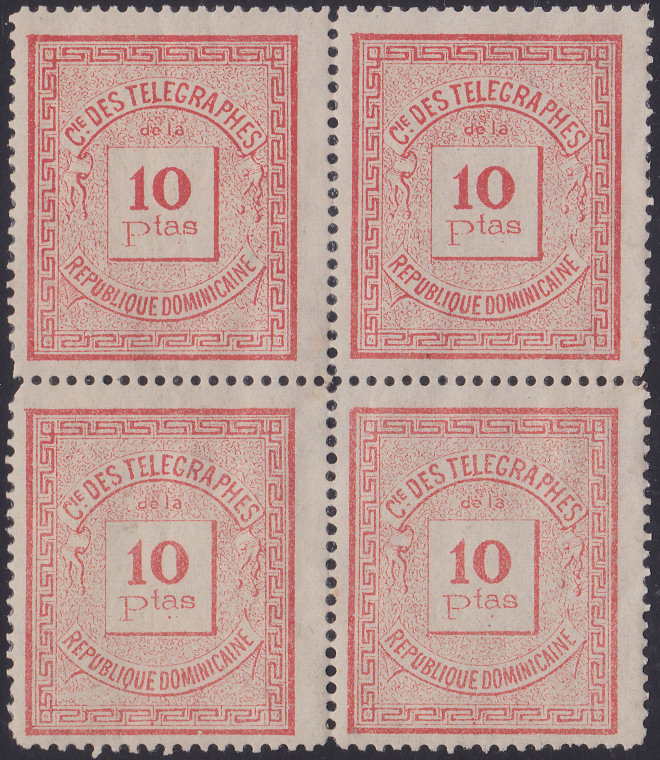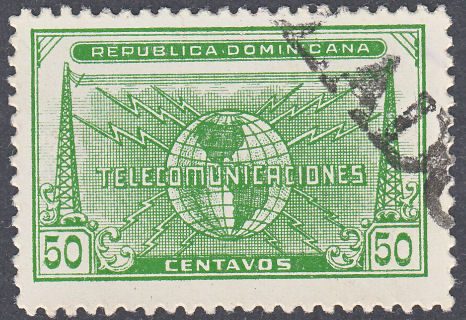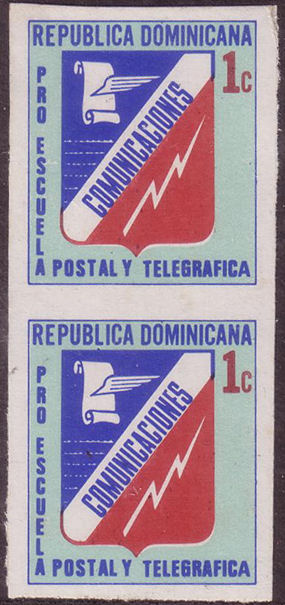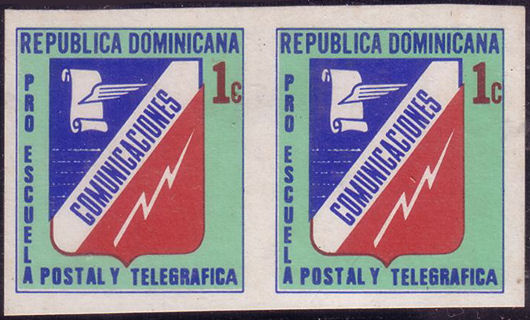| Up a level | ||||||||||
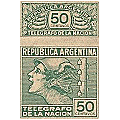 |
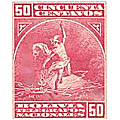 |
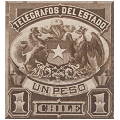 |
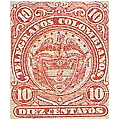 |
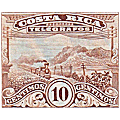 |
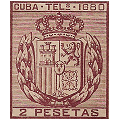 |
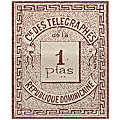 |
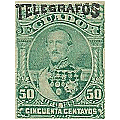 |
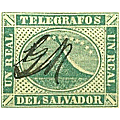 |
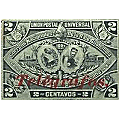 |
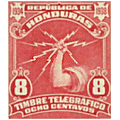 |
| Argentina | Bolivia | Chile | Colombia | Costa Rica | Cuba | Dominican Rep. | Ecuador | El Salvador | Guatemala | Honduras |
| Up a level | ||||||||||
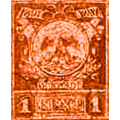 |
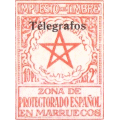 |
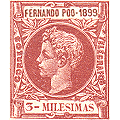 |
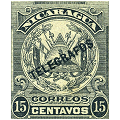 |
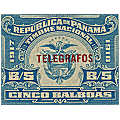 |
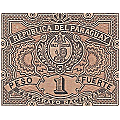 |
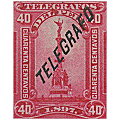 |
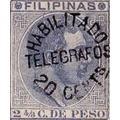 |
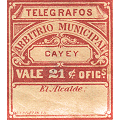 |
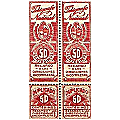 |
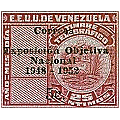 |
| Mexico | Morocco | Guinea | Nicaragua | Panama | Paraguay | Peru | Philippines | Puerto Rico | Uruguay | Venezuela |
Contributors: |
I have revised Hiscocks' original listing, though leaving references to the original designations. This is largely to accommodate additions. I have brought the prices up to date and added currency selection. The new designations have 'RH' numbers (Revised Hiscocks) to avoid confusion. CheckList Setup |
| Shortcuts to different sections | |||||||||||
| HAITI | DOMINICAN Rep. | French Co. | National | 1931 | TELECOMUNICACIONES | Centavo Oro | RD $ | Peso Oro | Service | Postal Tax Stamps | Seals |
Hispaniola.
A 1912 list of Wireless Telegraph Stations of the World, lists surprisingly little for this area. Willemstad, Curaçao had one, and Cuba had a dozen,
but none for the Dominican Republic, Haiti or Martinique. There are similarly named lists of stations for 1906, 1908 and 1910.

| According to Bill Glover, in 1888, La Société Française de Télégraphes Sous-Marin had Cables laid by CS Roddam from: Santo Domingo, Dominican RepublicWillemstad, Curaçao 453 nm. WillemstadLa Guaira, Venezuela 161 nm. and by CS Westmeath from : Santiago de CubaGuantanamo, Cuba 50 nm Guantanamo, CubaSaint Nicholas Môle, Haiti 125 nm St Nicholas MoleCap Haitien, Haiti 96 nm Cap HaitienPuerto Plata, Dominican Republic 116 nm Another cable was laid from Fort-de-France, Martinique to Puerto Plata, Dominican Republic (403 nm) in 1891. The beginnings of telephone and telegraph service began during the dictatorship of General Ulises Heureaux who did at least make improvements to the infrastructure of the country, including a single-track railroad linking Santiago and Puerto Plata. In 1916, at a time of chaos, the U.S. sent in a contingent of marines, who remained until 1924 when a democratically elected president (Horacio Vásquez) came to power, only to be overthrown in 1930 by Rafaél Leonides Trujillo Molina (A sergeant in the Dominican army trained by the marines) re-established dictatorship until his assassination in 1961. In 1962, Juan Bosch of the Dominican Revolutionary Party, became the new democratically elected president, but relations with Haiti became strained. Bosch was overthrown by a right-wing military coup in 1963 and armed conflict ensued. In 1965, fearing a possible Communist Dictatorship, 27,000 U.S. troops were back to 'restore order'. They installed a new president who was acceptable to the U.S. government. U.S. forces completely left in 1966. The new president, Joaquín Balaguer, opened the country up to foreign investment (mostly sugar and tourism) while protecting state-owned industries. Due to uneven distribution of new wealth, Balaguer lost the 1978 election, but refused to step down until U.S. President Jimmy Carter brought pressure to bear. This political turmoil, probably driven by economic challenges, appears to be reflected in the stamp issues. I think that as stamps were required, new tenders were put out and often stamp printing changed hands. This is here to get consistent results on different browsers. |
Haiti.
Though no specifically telegraph stamps are known for Haiti, it did have at least one National Telegraph Service and a later inland service.
Envelopes (c1895) are known in the red and blue colours of the Haitian flag, marked "Service Télégraphique de la Republique d'Haiti", with the Haitian Coat of Arms and "A Déchirer" perforated flaps :
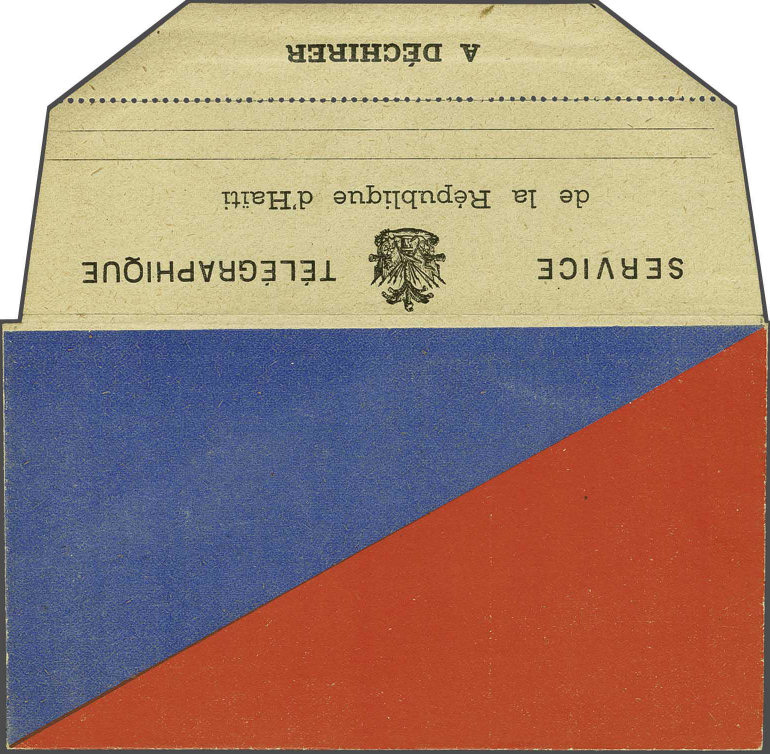
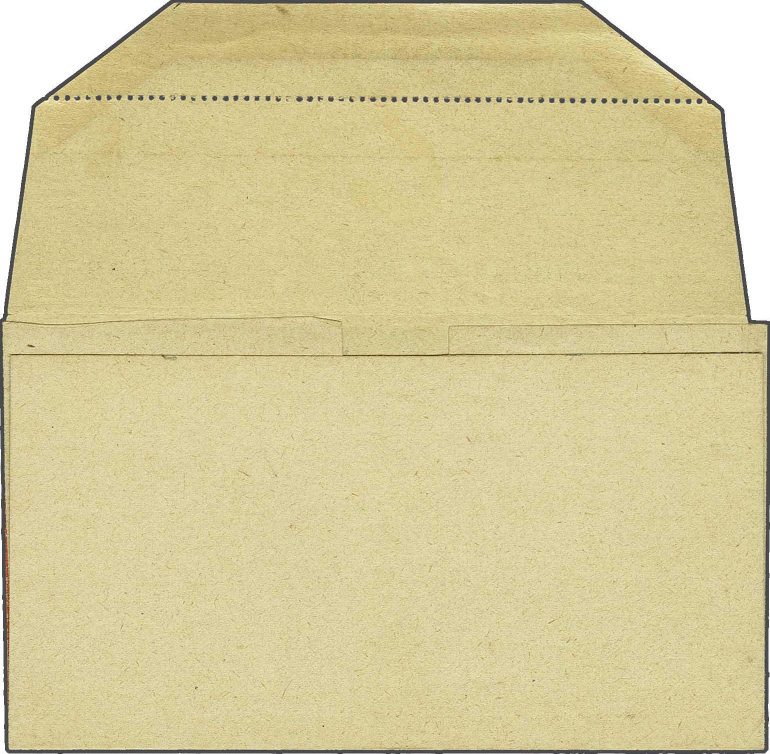
Envelope, front and back, courtesy of copyright holder, Corinphila Auction (Ex. Brian Moorhouse).
French Telegraph Cable Co. Form . - Headed "COMPAGNIE FRANCAISE DES CABLES TÉLÉGRAPHIQUES". This was used 13 September 1920.
New York to San Juan, Puerto Rico via "Hayti".
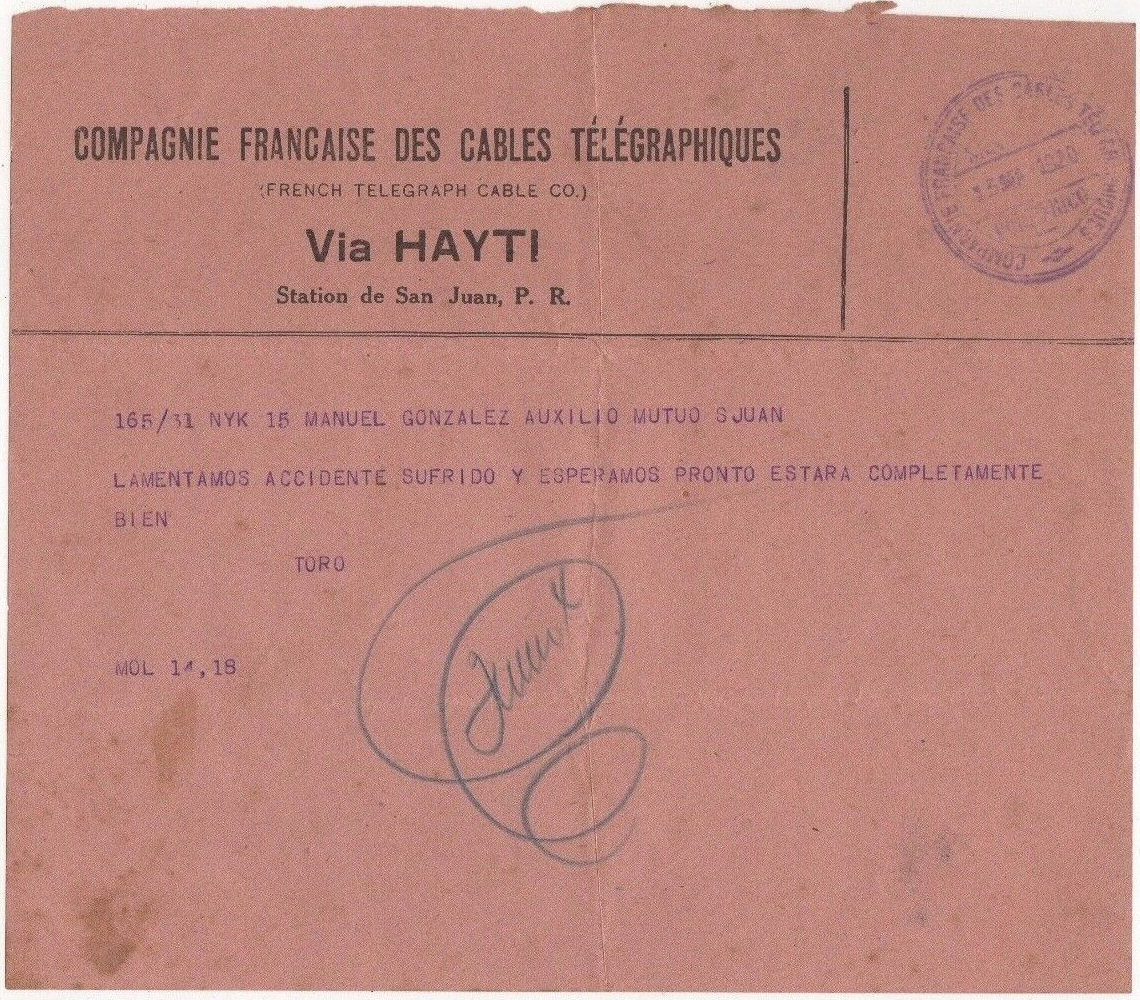
Listed on eBay by ElBotindeSanJuan in Puerto Rico.
Telegramme delivery forms of 1928 used in Port-Au-Prince are also known marked "Telegraphes Terrestres, Republique D'Haiti" (Formula TT 3).

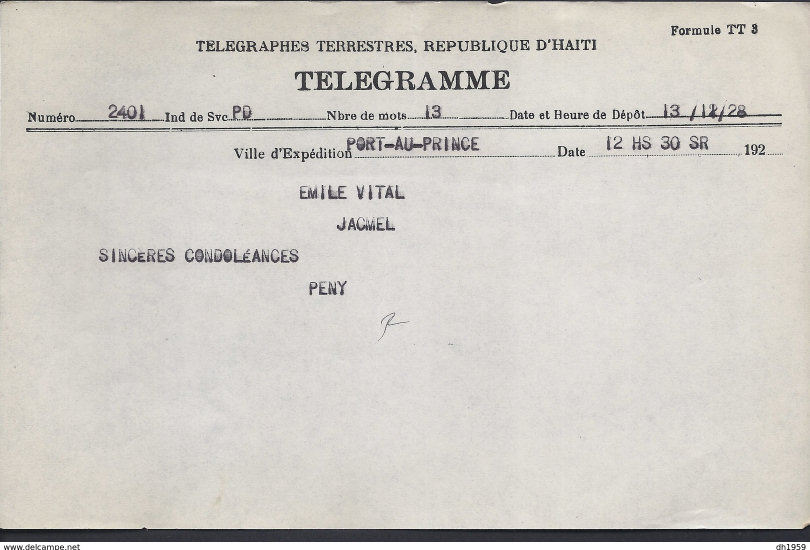

These all relate to the same death in the Vital family, but with some inconsistencies of filling in the date.
Two are from Jacmel, the other from Petit-Goâve. The "PD" for Service is probably "Paid to Destination".
Images courtesy of Perry (dh1959 on Delcampe. Click image for listing)
Nicolas Doire of The Haiti Philatelic Society has been very helpful in gathering information on Haiti.
I would be interested to hear from anyone with clearly telegraphic cancels of Haiti.
Dominican Republic.
Steve Hiscocks wrote (in 1982):
This country has the distinction of being the only country which still uses telegraph stamps today. The most recent issue was authorized by
Presidential decree in 1981. The first issue was by a French private company which was authorized to set up and run the first telegraph service
in the Republic. A reference in the American Philatelist to these being on sale at less than face value in 1890 suggests that they remained in use for
around two years at the most and that the remaining stock reached the philatelic market. It is not known how telegrams were prepaid for the
following 30 years until the issue of the first official telegraph stamps in 1920.
Full philatelic details of issues since that of 1931 have not become available in time for this edition, although it is hoped that complete data will be
available in due course. The numbers of each value issued between 1919 and 1981 are known and indicate a large usage.
My notes:
Unfortunately Steve Hiscocks did not live to produce a subsequent edition.
Notice his reference to a 1931 issue. He did not list that issue, only the similar, but different issue of 1935 (see below).
There is some disagreement about the sequence of issues. This is not helped by the almost complete absence of dateable examples.
Honduras issued stamps in 1981, and several more including a 1993 set. Hiscocks only knew of a 1934 set for Honduras.
Normally telegraph networks follow the railways, however the railways in the Dominican Republic appear to have had a slow start
The stamps of 1920 do not show railways, but instead show radiotelegraphy.
Private French Company ("Compagnie des Telegraphes de la Republique Dominicaine"").
1887 Wove paper. No watermark. Perf. 13½
Normal cancel of "TELÉGRAPHIQUE / DES ANTILLES" or "ANNULE".
Strangely, the number of dots under the value, generally two, is rather variable.
Hiscocks added the following note:
| Note. This issue is thought to have been in use for about two years at the most. |
My Note: It is said that this French company was nationalised in 1889 and that perhaps postage stamps were then used. What is the evidence?
In 1885 the country changed its currency from Franco to Peso and a new set of stamps were produced from 1c to 20c.
In 1891 it became necessary to add a 50c, 1p and 2p. To me that suggests that they may have been intended primarily for telegraphic use.
Those values were repeated in the 1899 series, but the 2p was dropped in the 1901-06 series, though the 1p had 3 issues. Then the use of high value postage stamps dried up.
Perhaps a system of cash and receipts was used. I would really like to hear from anyone who has any such receipts, or indeed telegrams.
National Issues.
1920 (January) Thick wove paper. No watermark. Perf. 11½ or 12.



Type 2, Basic 1920 set with typical cancels.
| RH # | Hisc. | Type. | Description | Mint | Used |
|---|---|---|---|---|---|
| RH6 | H6 | 2 | 1c green and blue | 5.00 | 3.75 |
| RH6a | H6a | perf. 12 (1921) | 7.50 | 5.00 | |
| RH7 | H7 | 2 | 5c deep blue | 8.00 | 2.50 |
| RH7a | H7a | perf. 12 (1921) | 12.50 | 3.75 | |
| RH8 | H8 | 2 | 10c yellow-olive | 10.00 | 2.50 |
| RH8a | H8a | perf. 12 (1921) | 12.50 | 3.75 | |
| RH9 | H9 | 2 | 25c chestnut (shades) | 10.00 | 2.50 |
| RH9a | H9a | perf. 12 (1921) | 12.50 | 3.75 | |
| RH10 | H10 | 2 | 35c red | 12.50 | 3.00 |
| RH10a | H10a | carmine, perf. 12 (1921) | 15.00 | 4.00 | |
| RH11 | H11 | 2 | 50c deep mauve | 18.00 | 5.00 |
| RH11a | H11a | perf. 12 (1921) | 25.00 | 7.50 | |
| RH12 | H12 | 2 | 1p yellow-green | 30.00 | 10.00 |
| RH12a | H12a | perf. 12 (1921) | 50.00 | 12.50 | |
| RH13 | H13 | 2 | 2p blue-grey | 50.00 | 20.00 |
| RH13a | H13a | perf. 12 (1921) | 60.00 | 25.00 | |
| RH14 | H14 | 2 | 5p red-orange | 100.00 | 30.00 |
| RH14a | H14a | perf. 12 (1921) | 110.00 | 40.00 |
The cancels on subsequent issues, is mainly in the form of a single-lined 'CANCELADO'.
This makes dating them difficult.
1931-5 Thick wove paper. No watermark. Perf. 11¾.
Steve Hiscocks makes reference to an issue of 1931 in his introduction, but instead lists a 1935 issue.
Yvert et Tellier lists the issue as 1931-40, with nothing after.
My thanks to Carlos Aristy for pointing out that there are two different types of these.
The differences are in the amount of shading on the globe and shading on the thunderbolts.
Detailed comparison suggests that the same plates were used for both types, since they have shared plate characteristics,
but that at some time, presumably around 1935, the plates were re-touched to enhance their contrast.
In places the shading is not completely removed from the thunderbolts. I do not yet know which values exist in which forms.
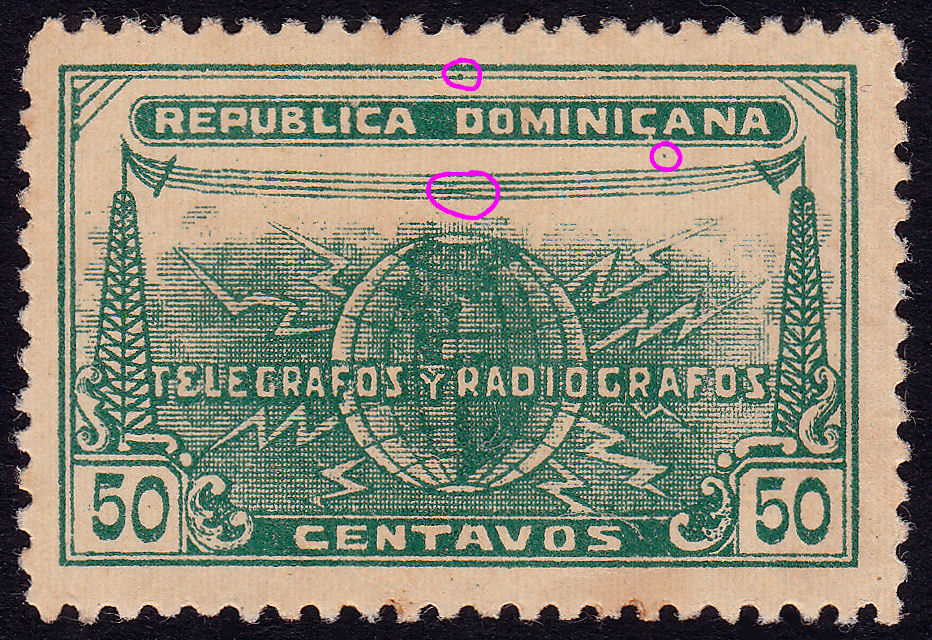
Plate characteristics marked in magenta.
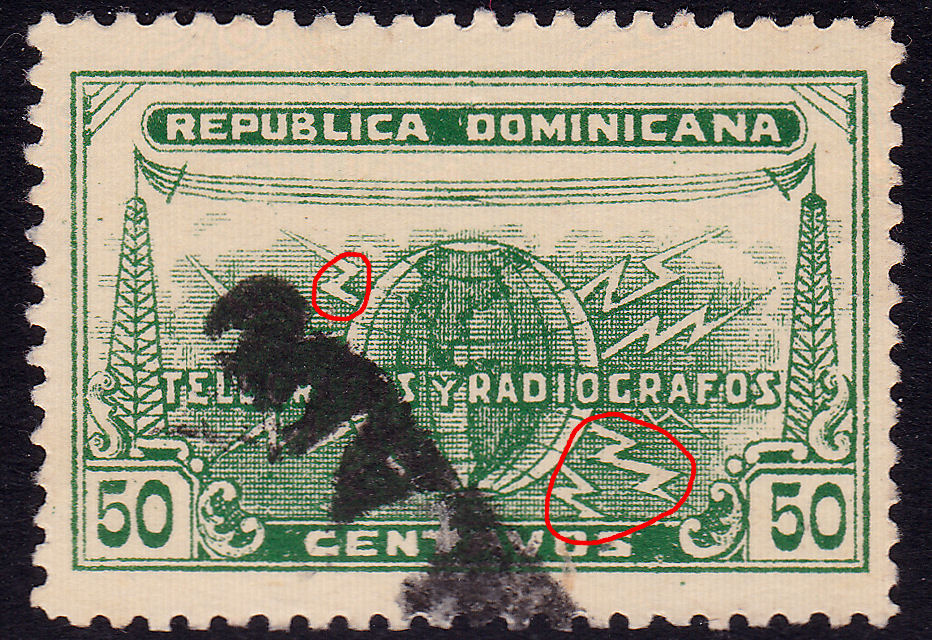
Shading reduced on globe and mostly cleared from thunderbolts. Remaining traces marked in red.
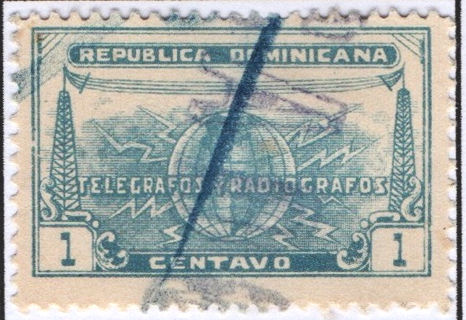 |
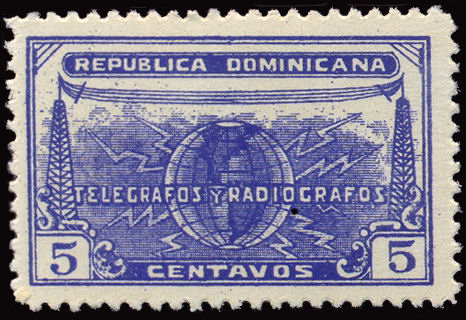 |
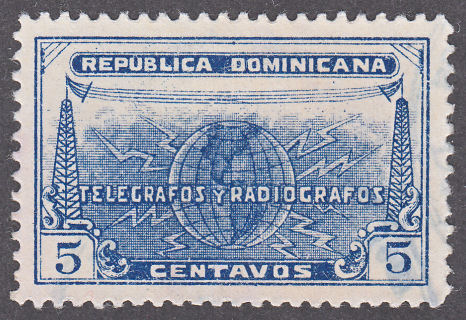 |
| H15 1c. - Courtesy of Paul & Les Bottomley | H16 5c. - from RL | H16a 5c. |
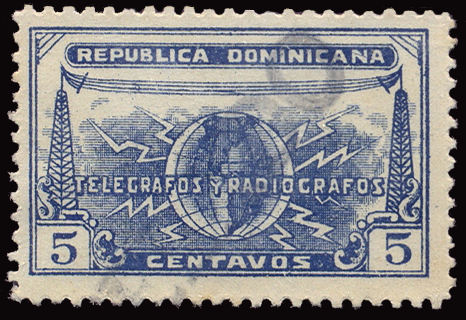 |
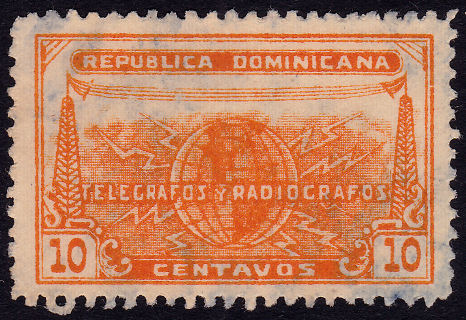 |
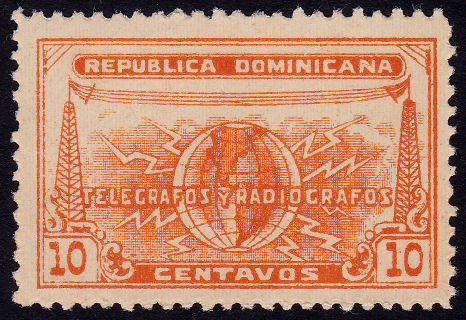 |
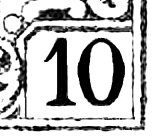 |
| H16ar retouched 5c. - from RL | H17 10c Type I. | H17r retouched 10c Type I. | 10c Type II. |
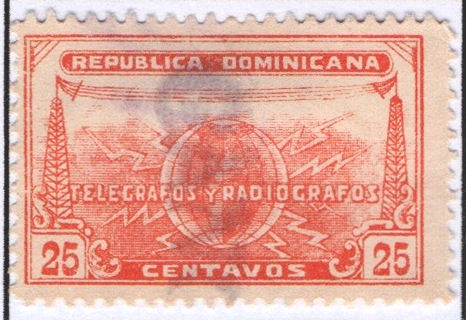 |
 |
| H19 25c. - Courtesy of Paul & Les Bottomley | H20 retouched 35c. - from RL |
The 35c above shows no traces of lines through the thunderbolts. I think there was no earlier 35c to retouch,
and that the first 35c was created like this, without the lines.
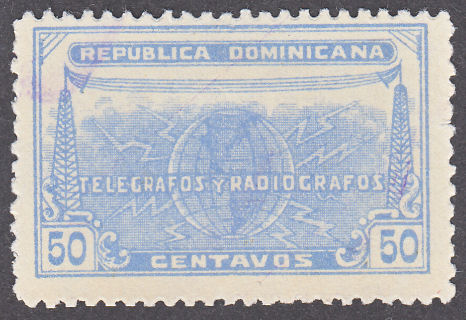 |
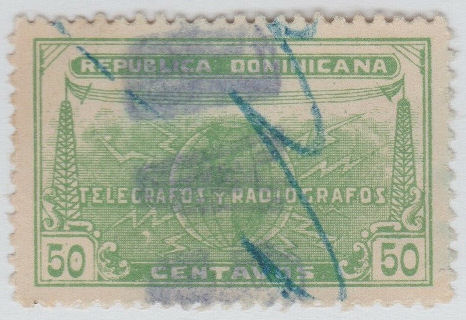 |
| H21 50c blue-grey. | H22 50c yellow-green. Courtesy of treasurings-jewelry on eBay (click on image for listing). |
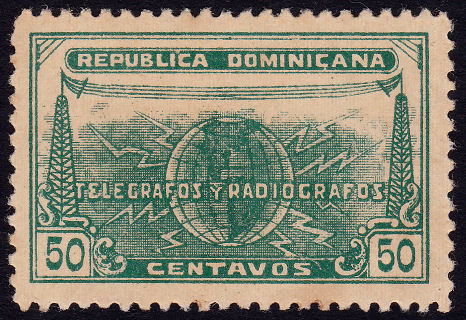 |
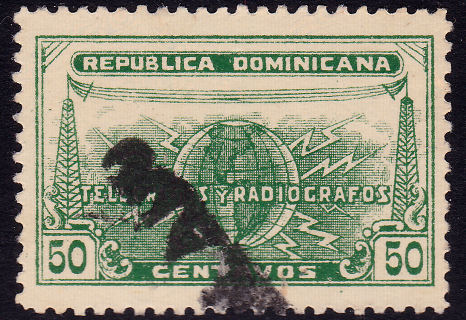 |
| H22a 50c blue-green. | H22r retouched 50c green. |
The positions of the values in the corners is variable.
| RH # | Hisc. | Type. | 1931-5 Description | Mint | Used |
|---|---|---|---|---|---|
| RH15 | H15 | 3 | 1c pale blue | 6.00 | 4.00 |
| RH15a | H15a | 'CENTAVOS' in place of 'CENTAVO' (date ?) | 30.00 | 20.00 | |
| RH16 | H16 | 3 | 5c ultramarine | 3.75 | 2.00 |
| RH16a | H16a | blue | 7.50 | 2.50 | |
| RH16ar | - | retouched | 7.50 | 2.50 | |
| RH17 | H17 | 3 | 10c orange Type I | 5.00 | 2.50 |
| RH17r | - | retouched | 5.00 | 2.50 | |
| RH18 | H18 | 3 | 10c orange Type II (not retouched) | 15.00 | 10.00 |
| RH19 | H19 | 3 | 25c rose | 15.00 | 10.00 |
| RH20 | H20 | 3 | 35c rose-carmine | 18.00 | 12.00 |
| RH20r | - | retouched | 18.00 | 12.00 | |
| RH21 | H21 | 3 | 50c blue-grey | 20.00 | 15.00 |
| RH22 | - | 3 | 50c yellow-green | 20.00 | 15.00 |
| RH22a | - | blue-green | 20.00 | 15.00 | |
| RH22r | H22 | green retouched | 20.00 | 15.00 |
Hiscocks added the following 2 notes:
| Note 1. In the 10c of Type I the '1' in the value '10' has a square serif, while in Type II it has a thin sloping serif. |
| Note 2.
My source seems to suggest that only the 25000 copies of the 1c value printed in 1940 (No 15(a)) showed the 'CENTAVOS' variation, but I may have misunderstood. There were no 10c values printed in that year and the dates of Nos. 17 and 18 are not known. It seems likely that other die variations remain to be discovered in this series. |
My notes: I suspect that the 1c error of 'CENTAVOS' was the initial issue. It makes no sense to incorrectly change
to plural in 1940, then change back again for all subsequent issues. It is more likely that it was wrong initially and then corrected.
I suspect also that the 10c Types I and II are actually the wrong way around chronologically since Type II matches the style of the 1920
series and Type I matches the style of the 1945 series. I have now seen an example of Type II. It was not retouched.
1940? New design — 'TELECOMUNICACIONES' in place of 'TELEGRAFOS Y RADIOGRAFOS'.
3 Thunderbolts per corner instead of 2. Thick wove paper. No watermark. Perf. 11¾.
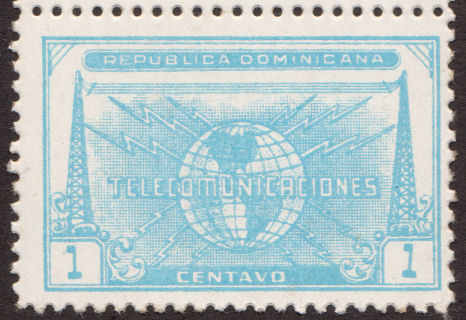 |
 |
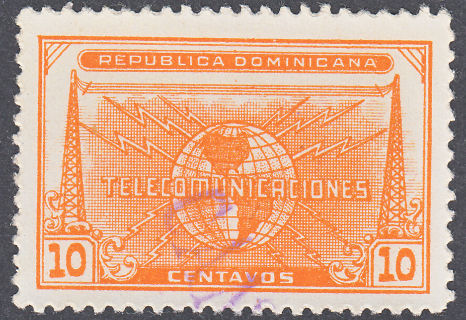 |
| H23 1c. | H24 5c. - Courtesy of Rodney Cork | H25 10c. |
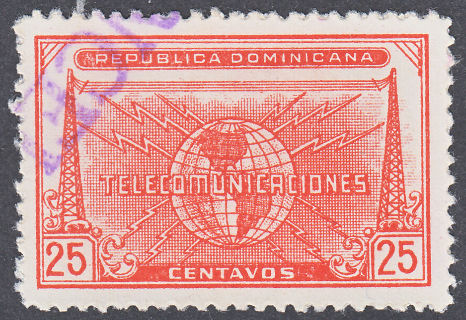 |
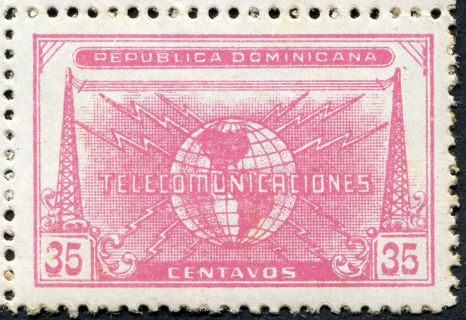 |
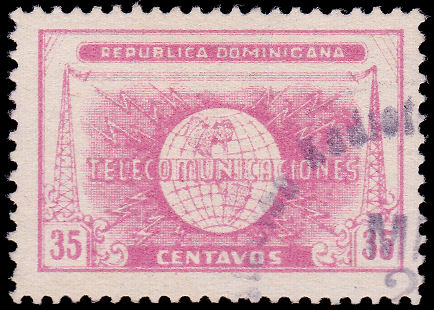 |
| H26 25c. | H27 35c. - Courtesy of Rodney Cork | RH27r 50c. |
From this point on, there is a lot of uncertainty of dates and even sequence of sets/partial sets.
There is disagreement between Hiscocks listing and a listing of the German Michel specialised catalogue.
Given that the German catalogue is a lot more complete, I will go according to that, but I suspect there may still be errors/omissions.
It is likely that during World War II, the Dominican republic had difficulty maintaining supplies of Telegraph stamps at a time when
they would likely be in increased demand. There may well have been contingency measures for which the documentation no longer exists.
This will entail extensive re-numbering (again), but it is still not likely to need further changes as there are still
a lot of gaps in the records for these. Some of Hiscocks designations, identified by face value, perforation and sometimes colour do not match his specified type.
I think that Hiscocks had correct information, but simply attributed it to the wrong stamps, having not known about several issues. I will match them as best I can.
Note: I have seen Scott references for some of these, so these are in some Scott catalogue,
but I do not know what the listing is like or how accurate and/or complete it is.
Information on that would be appreciated.
1946? - Type C New currency, simple numerals in bottom corners. White wove paper. No watermark. Perf. 11¾ or 12½.
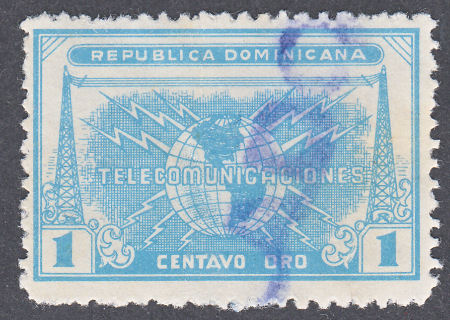 |
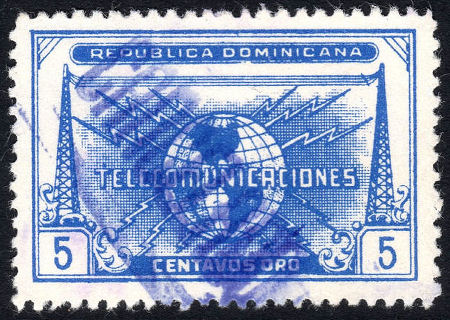 |
| RH30 1c oro. - Perf. 11¾ | RH31 5c oro. - Perf. 12½ derived from Wikimedia Commons. |
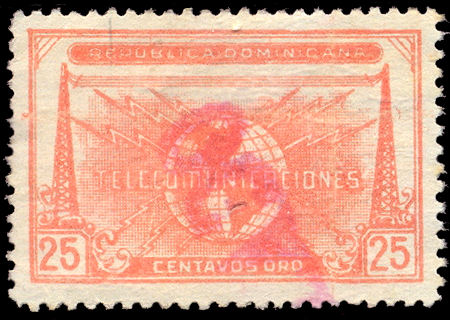 |
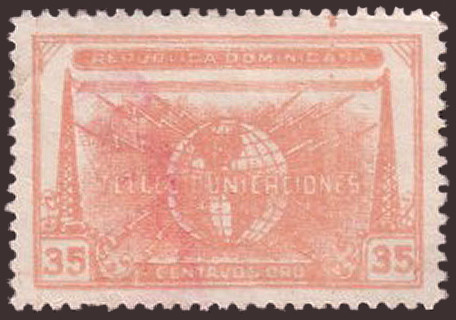 |
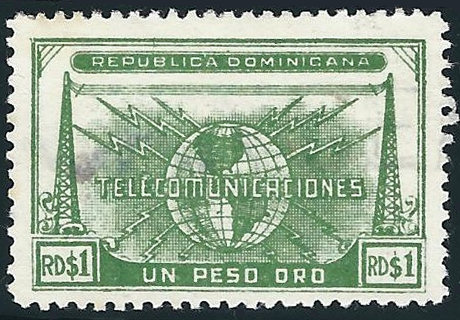 |
| RH33 25c oro. - Perf. 12½ - from RL | RH34 35c oro. - Perf. 12½ - from RL | RH36 1p oro. - Perf. 12½ - courtesy of Dick Keiser |
| RH # | Hisc. | Type. | Description | Mint | Used |
|---|---|---|---|---|---|
| RH30 | - | C | 1c light blue | 5.00 | 3.00 |
| RH31 | - | C | 5c blue | 6.00 | 4.00 |
| RH32 | - | C | 10c yellow-orange | 5.00 | 3.00 |
| RH33 | - | C | 25c orange-red | 15.00 | 10.00 |
| RH34 | - | C | 35c rose | 20.00 | 15.00 |
| RH35 | - | C | 50c yellow-green | 20.00 | 15.00 |
| RH36 | - | C | 1P blue-green | 20.00 | 15.00 |
1946? - Type D Re-drawn type. White wove paper. No watermark. Perf. 12½.
There are some general differences between the first and the re-drawn type.
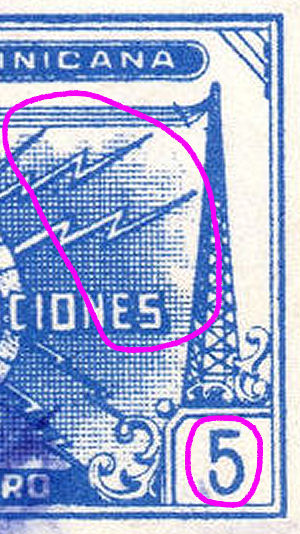 |
 |
| C The original has more extensive shading behind the thunderbolts and a large numeral. |
D The redrawn type has less extensive shading, smaller numerals and the top of the right ornament shorn off. |
Apart from the general differences, the numeral of the 1c has completely changed and at least some shades have changed.
The 25c is unusual in that the original value is large on both types.
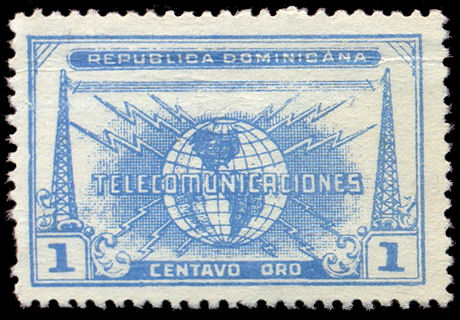 |
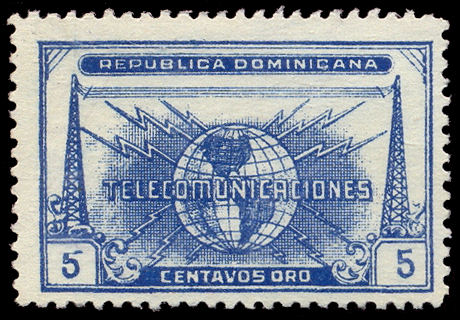 |
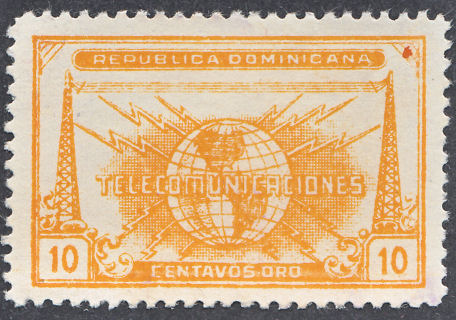 |
| RH37 1c oro. - Perf. 12½ - From RL | RH38 5c oro. - Perf. 12½ - From RL |
RH39 10c oro. - Perf. 12½ |
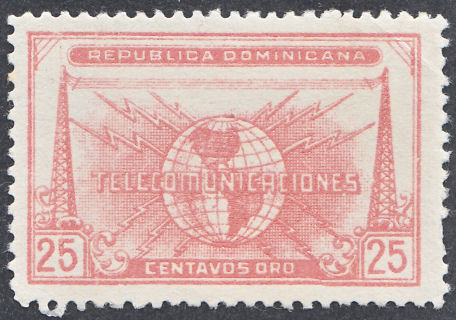 |
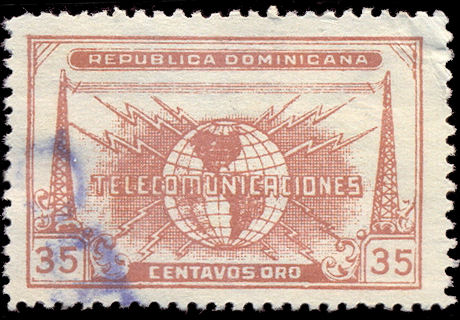 |
 |
| RH40 25c oro. - Perf. 12½ | RH41 35c oro. - Perf. 12½ - from RL | RH42 50c oro. - Perf. 12½ - from RL |
The size of the digits in the values on these appears to vary a lot. I would not be surprised if there were two types of some of these.
| RH # | Hisc. | Type. | Description | Mint | Used |
|---|---|---|---|---|---|
| RH37 | H39? | D | 1c blue | 5.00 | 3.00 |
| RH38 | H40? | D | 5c dark blue | 6.00 | 4.00 |
| RH39 | H41? | D | 10c red-orange | 5.00 | 3.00 |
| RH40 | H42? | D | 25c carmine-rose | 15.00 | 10.00 |
| RH41 | H43? | D | 35c yellow-brown | 20.00 | 15.00 |
| RH42 | H44? | D | 50c yellow-green | 20.00 | 15.00 |
There now follows a number of similar designs with values in the corners having 'RD$' and the CENTAVOS ORO values in decimals.
The insulators have been removed from the wires in the top corners (They come back with Type K).
Thick wove paper. No watermark.
Type Ea 1952, Perf. 11¾, Granite paper
Type Eb 1952, Perf. 11¾
Type F 1952, Perf. 11¾
Type G 1953, Perf. 11¾
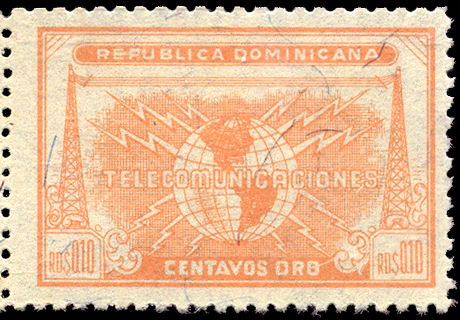 |
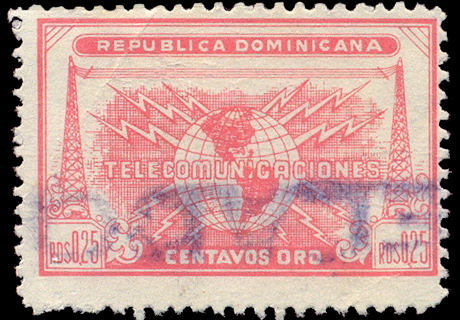 |
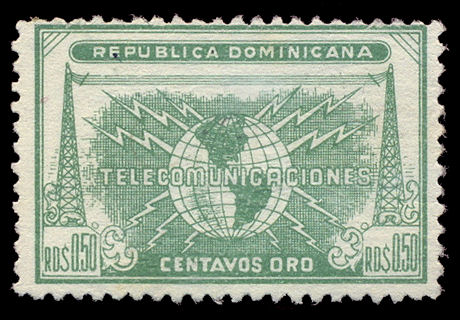 |
| Type-E RH43, 10c oro. - Perf. 11¾ - from RL | Type-E RH44, 25c oro. - Perf. 11¾ - from RL | Type-F RH45, 50c oro. - Perf. 11¾ - from RL |
 |
 |
| Type-G RH46, 1P oro. - Perf. 11¾ - from RL | Type-G RH46, 1P oro. - Perf. 11¾ |
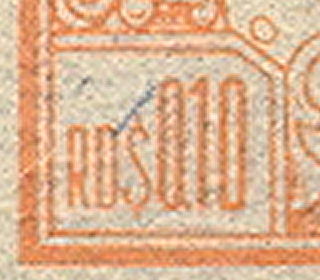 |
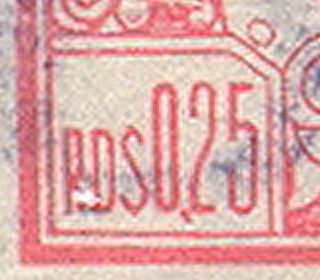 |
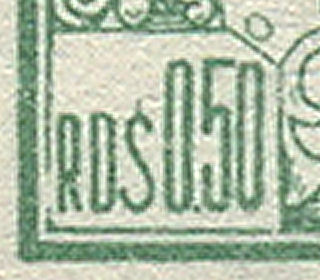 |
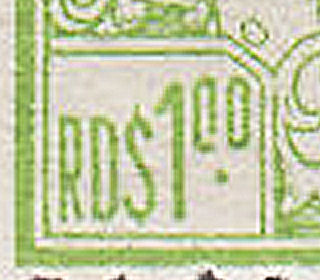 |
| Type-Ea RD$ 1.7mm high. Decimal point '.' |
Type-Eb RD$ 1.7mm high. Comma ',' |
Type-F RD$ 2.0mm high. Single-line frame. |
Type-G RD$ 2.0mm high. Double-line frame. |
| RH # | Hisc. | Type. | 1952-53 Description | Mint | Used |
|---|---|---|---|---|---|
| RH43 | - | E | 10c orange (Perf.11¾, 1952) | 10.00 | 5.00 |
| RH44 | - | E | 25c rose-red (Perf. 11¾, 1952) | 15.00 | 15.00 |
| RH45 | - | F | 50c blue-green (Perf. 11¾, 1952) | 30.00 | 20.00 |
| RH46 | - | G | 1p green (shades) (Perf. 11¾, 1953) | 35.00 | 25.00 |
1966? - Type H (Hiscocks Type 5), Smaller corner-value characters. Single-line frame around values.
Chalk surfaced paper. No watermark. Various perforations as indicated. Lith. Printed by Padilla Offset.
According to the Padilla website, the company was founded in Santo Domingo on January 20, 1964 and among other things, printed stamps until 1988.
From this it seems clear that the reported date for these of 1952/3 is in error.
Hiscocks lists similar stamps as being 1966, which sounds more reasonable.
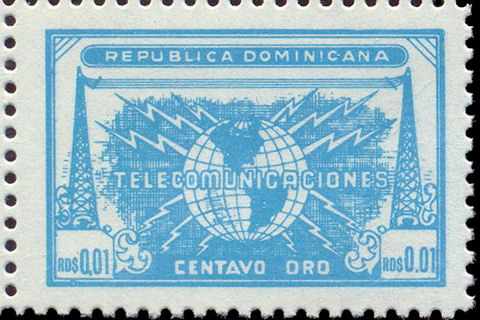 |
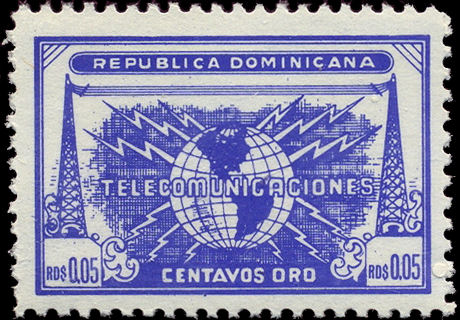 |
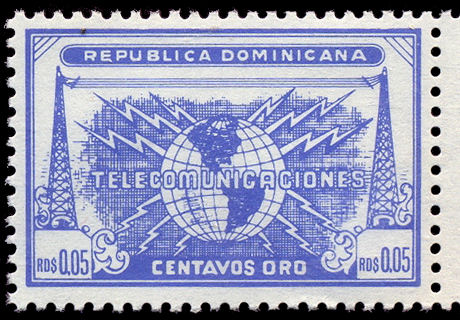 |
| Type-H RH47, 1c oro. - Perf. 10½ - From RL | Type-H RH48, 5c oro. - Perf. 11 - From RL | Type-H RH48a, 5c oro. - Perf. 12 - From RL |
 |
| Type-H RH49a 1P oro. - Perf. 12 x 11¾ - From RL |
| RH # | Hisc. | Type. | 1966? Description | Mint | Used |
|---|---|---|---|---|---|
| RH47 | H30? | H | 1c new blue (Perf.10½) | 10.00 | 8.00 |
| RH47a | H30a | H | perf. 12¼ x 12 (1978) | 10.00 | 8.00 |
| RH48 | H31 | H | 5c bright blue (Perf.11) | 10.00 | 8.00 |
| RH48a | - | H | blue, perf. 12 | 10.00 | 8.00 |
| RH49 | H36 | H | 1p blue-green perf. 11 | 35.00 | 25.00 |
| RH49a | H36a | H | perf. (Perf. 12 x 11¾, 1978?) | 30.00 | 30.00 |
| RH50 | H37 | H | 2p colour ? (Perf. 11?) | 60.00 | 50.00 |
| RH51 | H38 | H | 5p colour ? (Perf. 11?) | 100.00 | 80.00 |
1967? - Type I Similar to last, but Double-line frame around values. Litho. Printed by Padilla Offset.
Thick wove paper. No watermark. Various perforations as indicated.
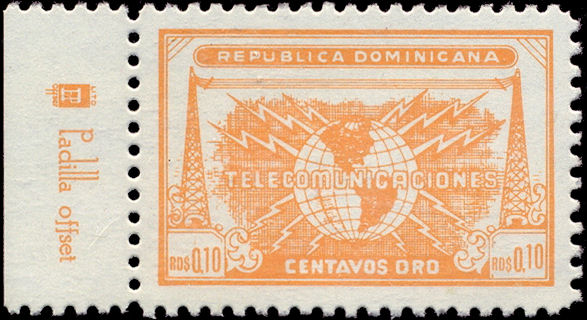 |
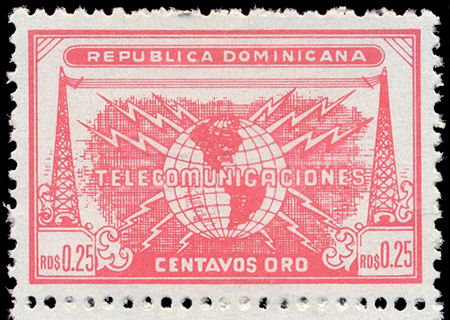 |
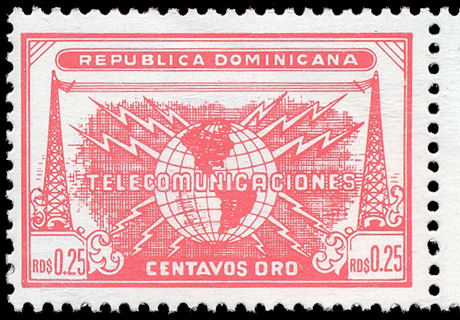 |
| Type-I RH52, 10c oro. - Perf. 10½ - From RL | Type-I RH53a, 25c oro. - Perf. 12 - From RL | Type-I RH53b, 25c oro. - Perf. 12 x 11¾ - From RL |
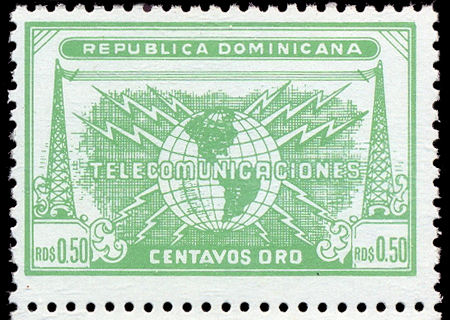 |
| Type-I RH55a, 50c oro. - Perf. 12 - From RL |
| RH # | Hisc. | Type. | 1967? Description | Mint | Used |
|---|---|---|---|---|---|
| RH52 | H32? | I | 10c orange (Perf.10½) | 10.00 | 5.00 |
| RH53 | H33 | I | 25c rose-red (Perf.11) | 20.00 | 12.00 |
| RH53a | - | I | 25c rose-red (Perf. 12) | 15.00 | 15.00 |
| RH53b | H33a? | I | Perf. 12 x 11¾ (1978?) | 15.00 | 15.00 |
| RH54 | H34 | I | 35c carmine ? (Perf. 11) | 20.00 | 15.00 |
| RH55 | H35 | I | 50c green ? (Perf. 11?) | 30.00 | 20.00 |
| RH55a | H35a? | I | Perf. 12, 1978?) | 25.00 | 25.00 |
1970? - Type K (No Type J apparently), This is a high quality and very distinctive production. Perf. 11¾.
Insulators are back in the top corners. Lightning without tips. Value in simple numerals.
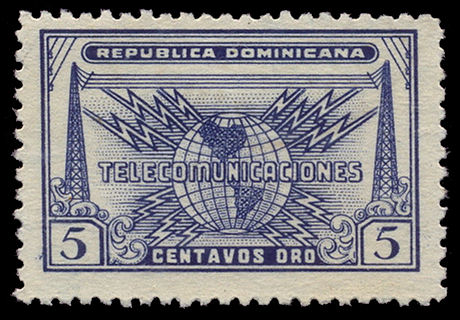
Type K, RH56, 5c oro - From RL
| RH # | Hisc. | Type. | 1970? Description | Mint | Used |
|---|---|---|---|---|---|
| RH56 | - | K | 5c oro. Dark blue | - | - |
I have no idea if there are any more values in this design, or even who printed it.
1979-81 - Type L Another distinctive issue with value in words at the bottom. 'ORO' now dropped on the centavos values. Perf. 13¼ x 13½.
Chalk surfaced paper. Printed by Litografia Ferrua & Hnos, Cxa. of Santo Domingo, founded in January 1976.
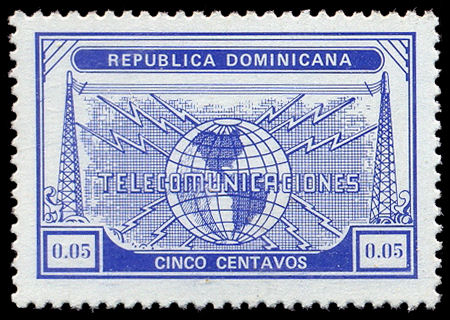 |
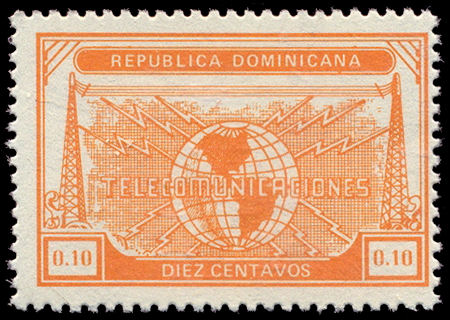 |
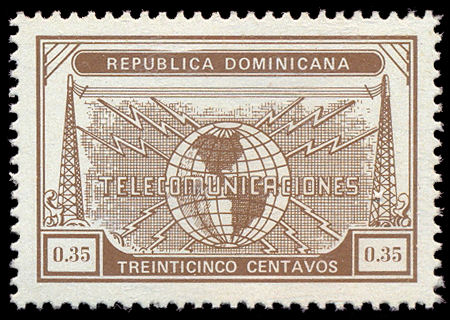 |
| Type-L RH57, 5c. - From RL | Type-L RH58, 10c. - From RL | Type-L RH60, 35c. - From RL |
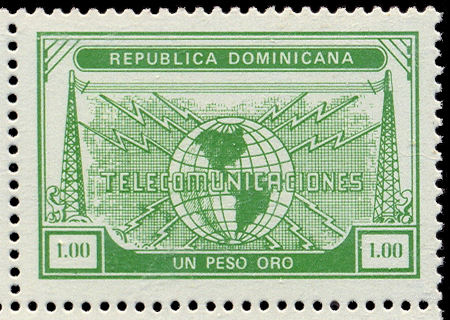 |
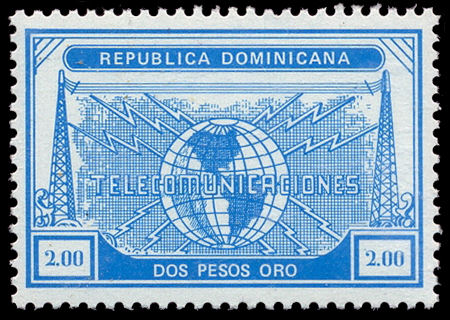 |
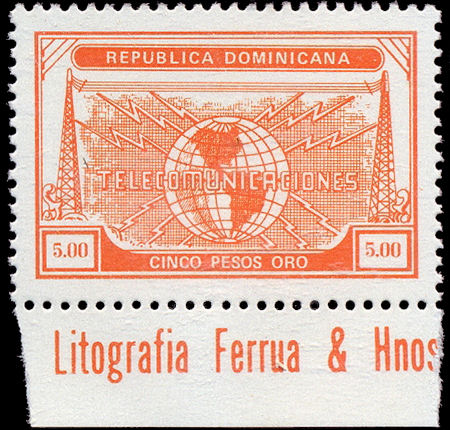 |
| I have added an RH61 on the expectation that there would be another value between 35c and 1 Peso. |
Strangely this is missing the insulators from the top-right corner. |
|
| Type-L RH62, 1 Peso - From RL | Type-L RH63, 2 Pesos - From RL | Type-L RH64, 5 Pesos - From RL |
| RH # | Hisc. | Type. | Description | Mint | Used |
|---|---|---|---|---|---|
| RH57 | - | L | 5c dark blue | 15.00 | 15.00 |
| RH58 | - | L | 10c orange | 15.00 | 15.00 |
| RH59 | - | L | 25c rose-red? | 20.00 | 20.00 |
| RH60 | - | L | 35c brown | 20.00 | 20.00 |
| RH61 | - | L | 50c? colour ? | 25.00 | 25.00 |
| RH62 | H45? | L | 1p green (1981) | 30.00 | 20.00 |
| RH63 | H46? | L | 2p light blue(1981) | 50.00 | 40.00 |
| RH64 | H47? | L | 5p orange (1981) | 75.00 | 60.00 |
My notes: Steve Hiscocks' book was published in 1982 so would not have included any issues after that.
He did note that 'The most recent issue was authorized by Presidential decree in 1981.'
Anyone that has access to subsequent decrees may find further information.
I have had great difficulty in finding information about these issues so assumptions have been made.
Entries where I have not been able to give the colour, may not even exist.
By the same token, there may be items that are not listed.
It is likely that different issues were printed by different companies, but I have no information on most of them.
Further information is invited and would be very welcome.
Service Stamps.
1959 White wove paper. No watermark. Perf. 11¾.
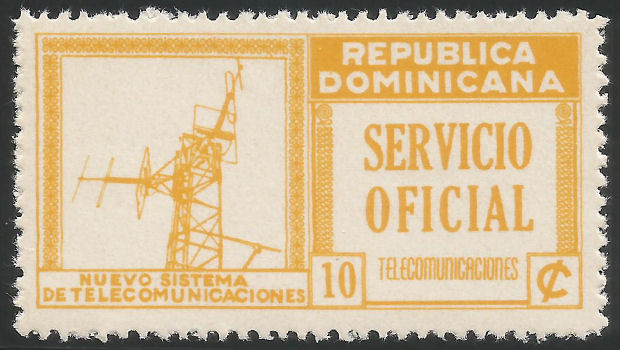
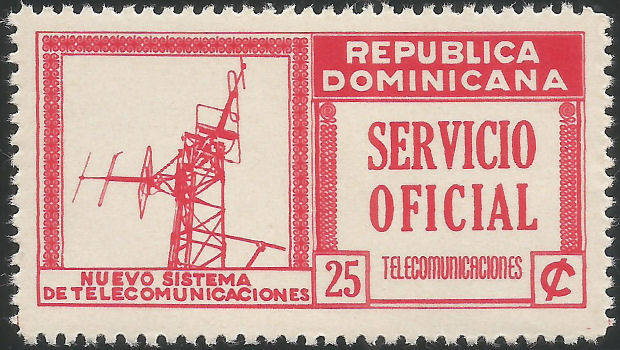
Type 7 courtesy of Carlos Aristy.
| RH # | Hisc. | Type. | Description | Mint | Used |
|---|---|---|---|---|---|
| RHS1 | S1 | 7 | 10c yellow (3,000,000) | - | - |
| RHS2 | S2 | 7 | 25c red (3,000,000) | - | - |
The Scott catalogue illustrates a 25c green in this design with 'ENTREGA / ESPECIAL / CORREOS'
on the right hand side. It is listed as E8, 1956 (August 8, Perf. 11½) under Special Delivery Stamps.
There is almost certainly gaps in this.
If anyone can provide scans to help with this, I am happy to give appropriate acknowledgement.
Postal Tax Stamps.
There are a number of Postal Tax stamps that may have been required for use on telegrams Further information is needed.
For the moment at least, I will list them since it seems very unlikely that they would put this tax only on mail and not on telegrams.
Tax to raise money for the Communications school of the Posts and Telegraphs. Litho.
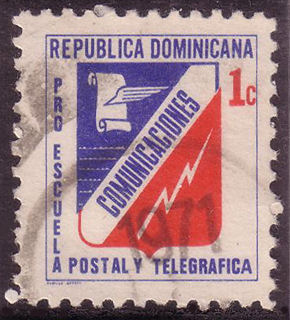 |
 |
 |
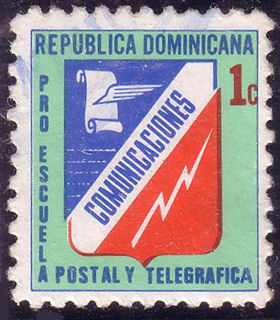 |
| 1971, Jan 2 | 1972, Jan 3 | 1973, Jan 2 | 1973, Nov 3 |
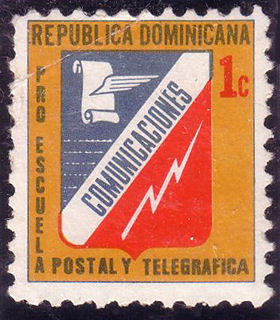 |
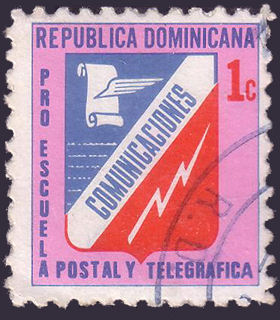 |
 |
| 1974, Nov 13 | 1977, Jan 7 | 1981, Feb |
The shields are all about the same colours (Violet-blue, white and red), I will give the colours of the background and (1c) value.
Images from RL
Telegram Seals.
A couple of similar but different seals are known for use on telegrams in the Dominican Republic.
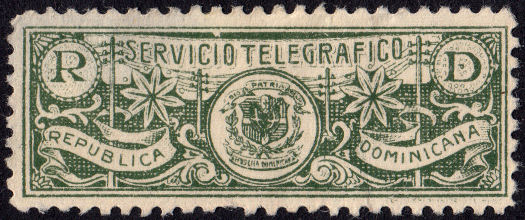
Steve Hiscocks made a start on cataloguing seals of the world in a book he published in 2007.
It was his hope to update it later, but unfortunately that was not to be.
His original book can be viewed at
Telegraph Seals: A World Catalogue. There are links from the pages to my updates.
Alternatively you can view the latest page for Dominican Republic.

